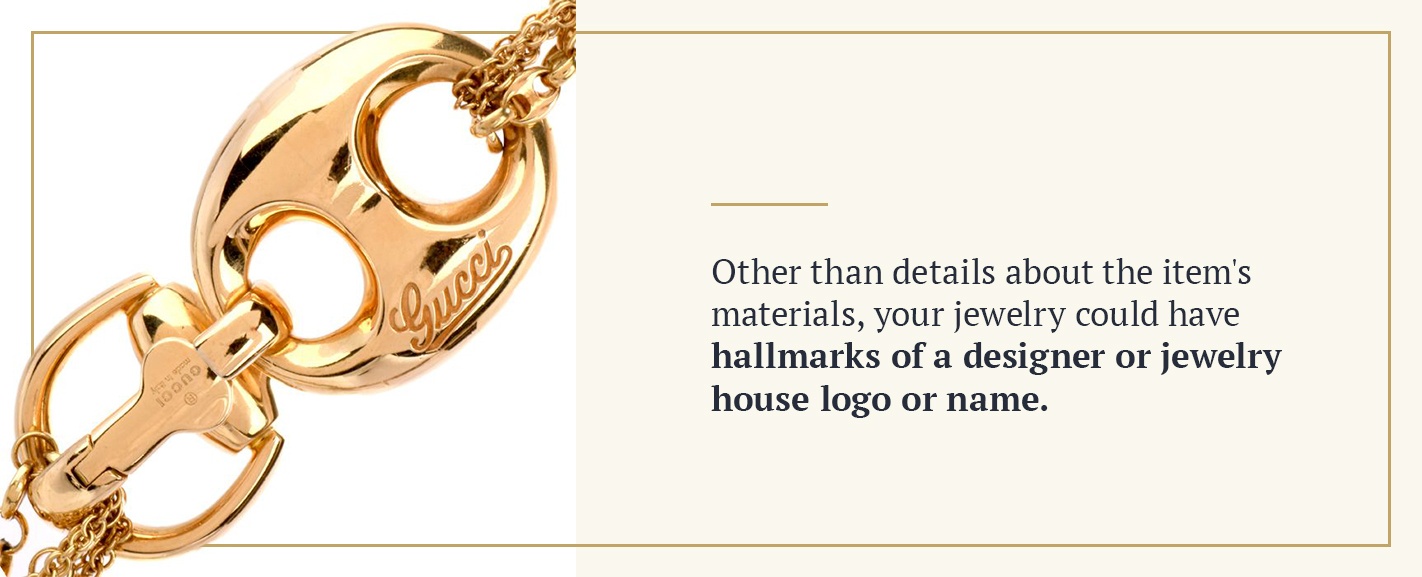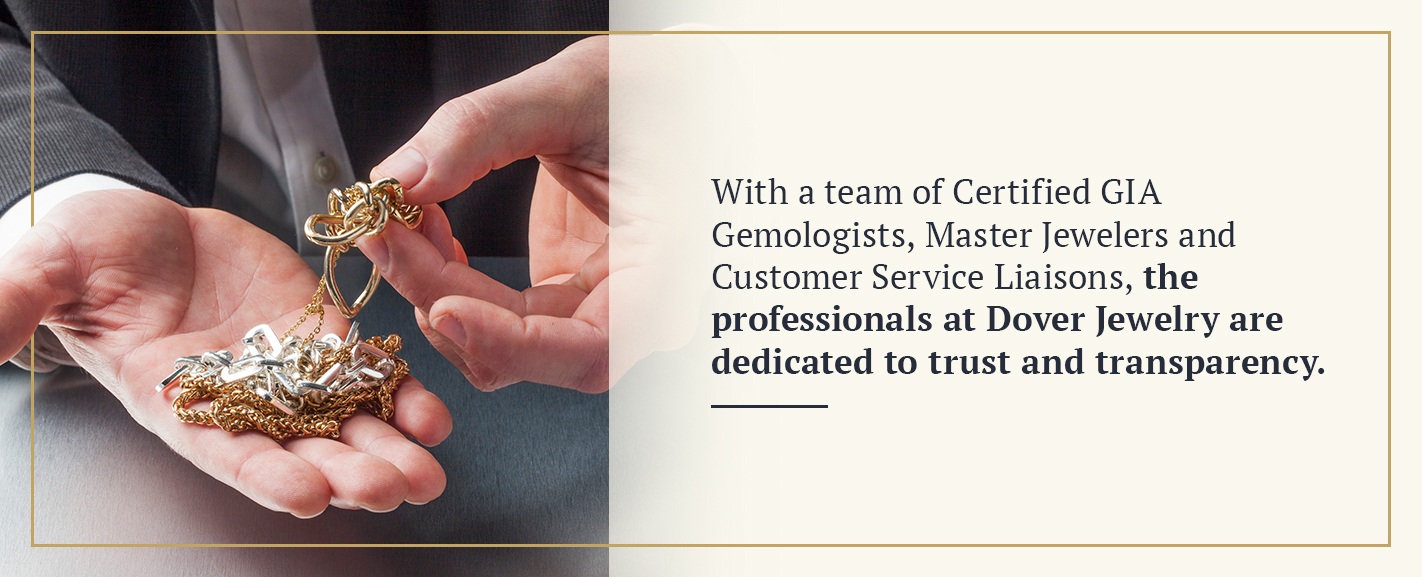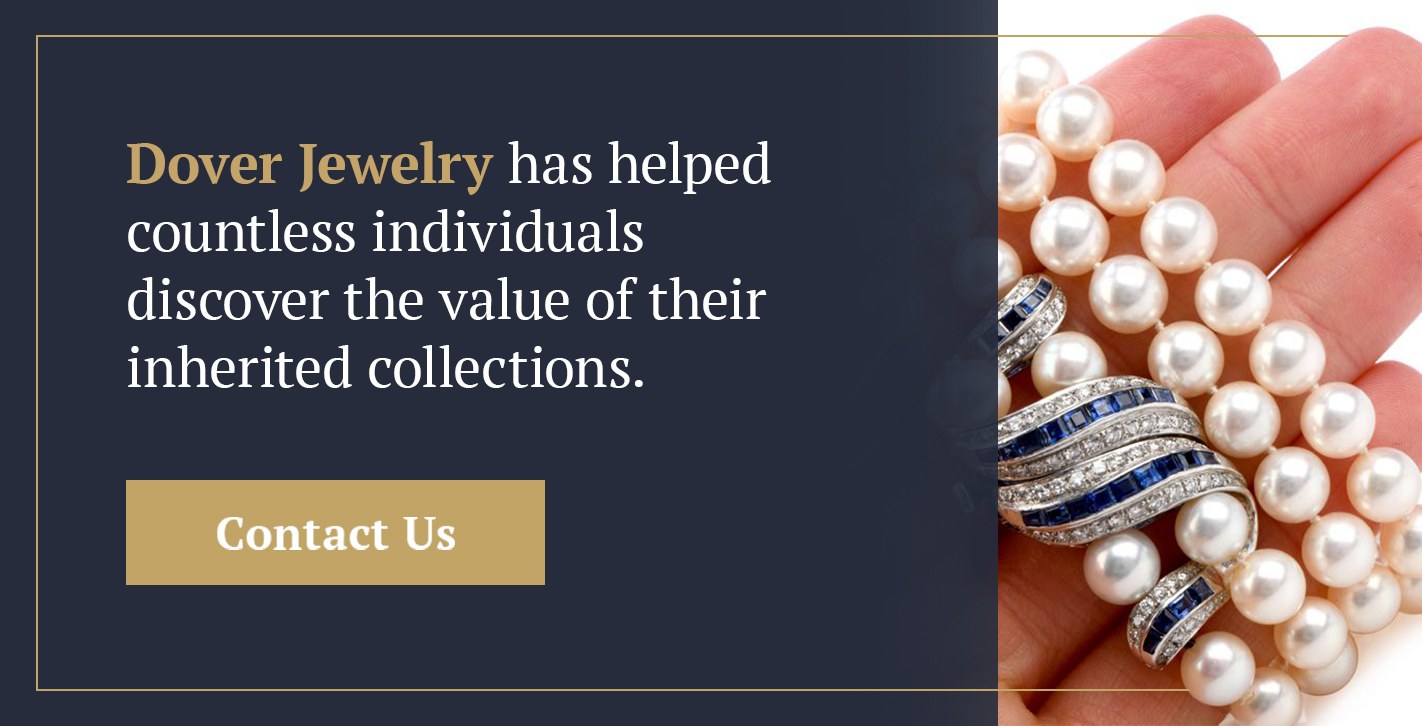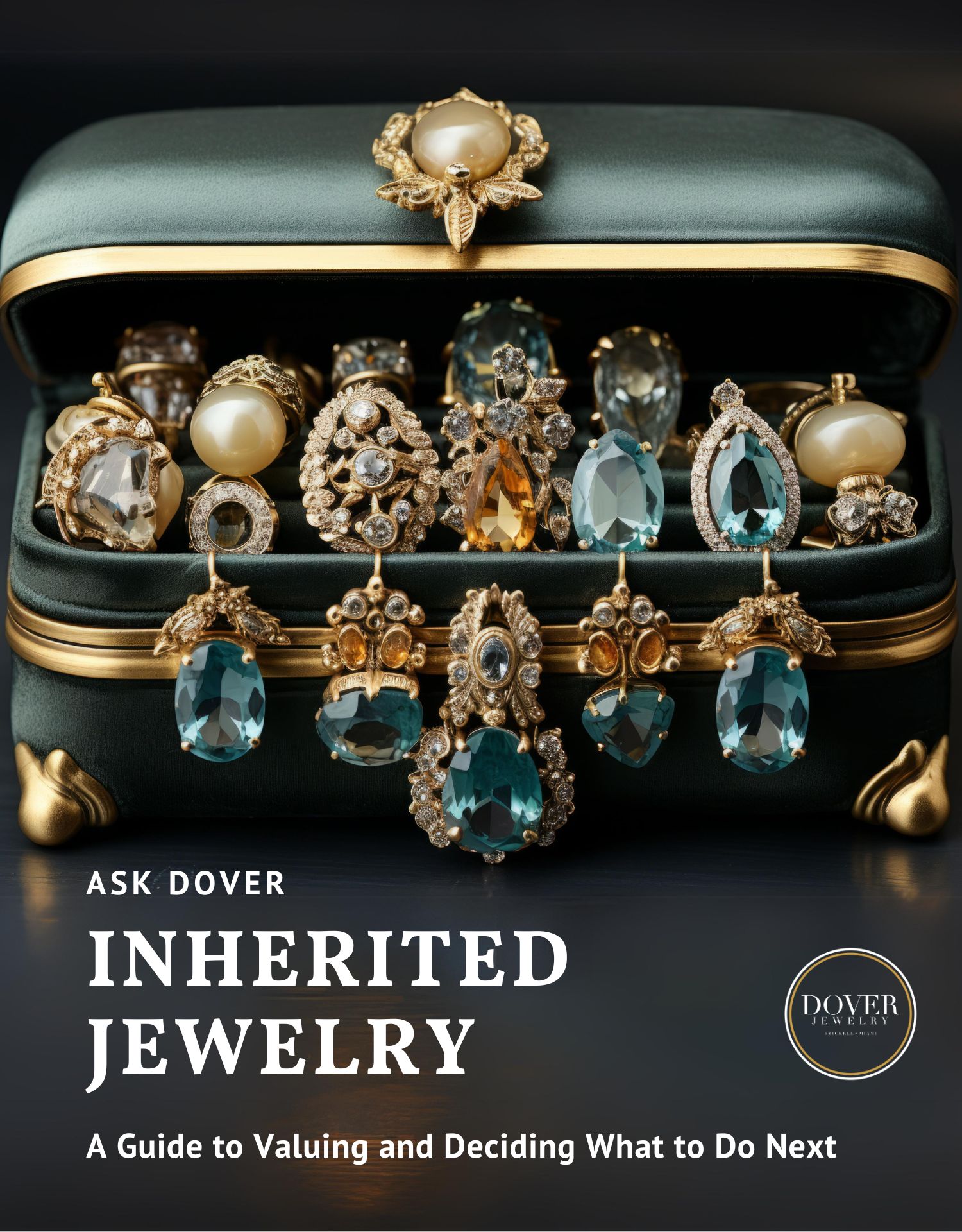
Navigating Inherited Jewelry
A Guide to Valuing and Deciding What to Do Next.
Inheriting jewelry often comes with mixed emotions and the challenge of deciding what steps to take next. Whether you’re admiring pieces from afar or managing a large collection as an executor, understanding the value of estate jewelry is crucial. This guide is designed for those who have recently inherited jewelry, offering insights on whether to keep, sell, or further explore the items’ worth. We aim to simplify the overwhelming process of sorting through inherited pieces by providing practical steps for identifying valuable jewelry, both independently and with professional assistance. Join us as we delve into effective strategies for assessing the value and making informed decisions about your inherited treasures.
If you wish to determine jewelry estate value, you can begin by examining the collection yourself. Understanding how to appraise jewelry yourself can give you a rough estimation of the collection’s state and quality. You will ultimately need an expert’s help, but an at-home jewelry appraisal helps you decide what pieces are costume and which to get a second opinion on. Consider these steps to identify valuable pieces in your inherited collection:
1. Find Jewelry Stamps
Also referred to as a maker’s mark or hallmark, a jewelry stamp denotes authenticity and reflects the piece’s jewelry house and materials. A maker’s mark may offer insight into the value of inherited jewelry, so this is an excellent feature to look for. Hallmarks commonly provide details about the item’s materials, such as the metal used.
There are various marks a jewelry house could use to denote the metal in a piece of jewelry. The stamp you find will depend on the type and quality of metal used to create a piece, with possibilities including:
- Gold: 10K, 14K, 18K or 22K
- Platinum: 850, 950 or PLAT
- Stainless steel: 316L
- Sterling silver: 925 or STERLING
Not all hallmarks will use those exact numbers or letters. You might research what you find on your jewelry to discover what type of metal it contains and additional information.
Along with details of the metal, jewelry hallmarks could also have information about a piece’s gemstone. These qualities often include carat weight, written in figures such as 0.90. A gemstone’s carat weight is useful for discovering the value of jewelry. If you do not see this information, a professional appraisal can estimate the carat weight of gemstones in your inherited jewelry.
Other than details about the item’s materials, your jewelry could have the hallmarks of a designer or jewelry house logo or name. If the logo or name is recognizable, such as Tiffany & Co., Cartier or another well-known designer, you could have a valuable piece of fine jewelry. However, a lack of a designer’s hallmark does not mean your fine jewelry lacks value.
Once you know what to search for, you also need to understand how to find jewelry hallmarks. Fine jewelry almost always has a stamp, but a primary exception is if it has worn off over time with wear. Use a magnifying glass or jeweler’s loupe to see small hallmarks. Where are jewelry stamps? Depending on the piece you have, you will often find the jewelry stamp on the:
- Inside a ring or bracelet
- Post of an earring
- The clasp of a necklace
Some antique jewelry — that is, pieces over 100 years old — and vintage items may not have stamps. You will have to judge their potential quality based on their appearance and weight. If a piece feels heavy, it might be fine jewelry, even if it does not have a stamp. Evaluating these qualities will help determine if your jewelry is fine or costume. A lighter weight and no stamp could indicate a costume piece, but you can always get a professional opinion.
2. Test the Metal
If you’ve searched for a stamp and could not find one, try other methods for identifying valuable jewelry. Fine and costume jewelry contains various metal types. While a maker’s mark may indicate if a piece includes precious metals, there are additional ways to test jewelry metal and double-check that the hallmark is accurate.
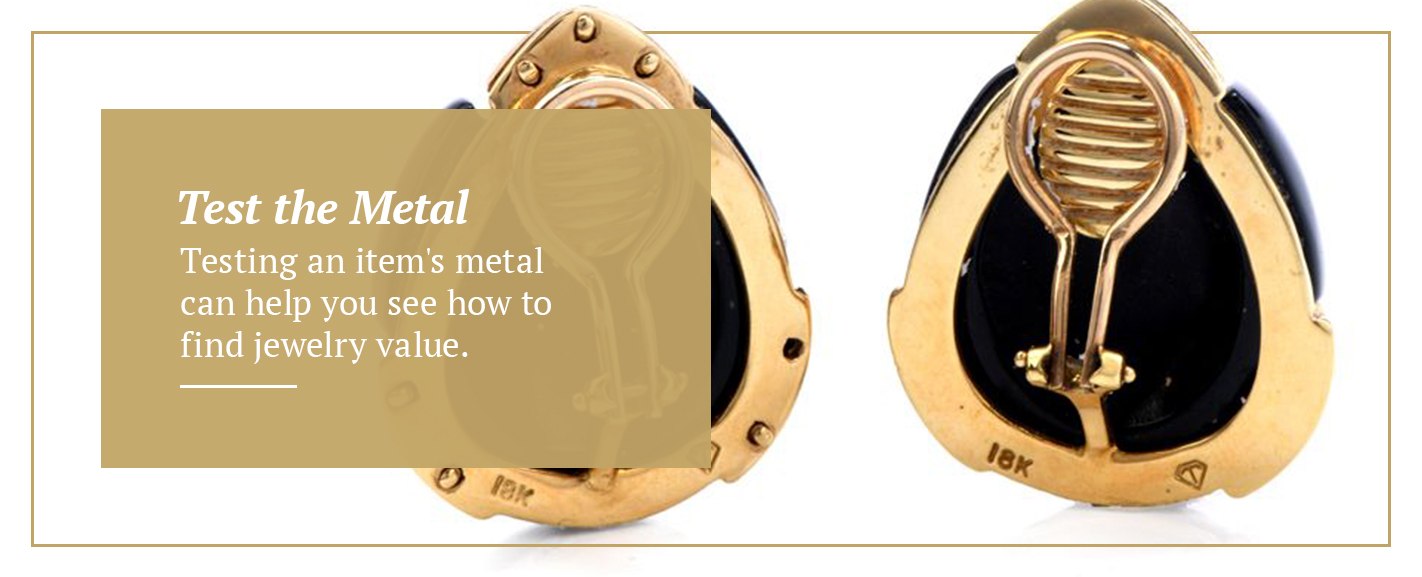
Testing an item’s metal can help you see how to find jewelry value. With precious metals — like gold, silver and platinum — in higher purity, pieces are often worth more. Alternately, you could discover alloys, or combinations of metallic elements, with lower precious metal ratios. Determine the purity of your jewelry and test the metal by:
- Checking for wear: Clasps, the back of a pendant, points where chains link together and inside bracelets and rings are more susceptible to wear than other areas. Check those spots for signs of fading or scratching. If you can see brass or copper showing through, your piece was likely plated in silver, gold or another metal. That doesn’t mean that it isn’t worth anything, but jewelry with pure precious metals are worth more.
- Looking for tarnishing: Precious metals aren’t as likely to tarnish as other metals are, especially when they’re purer. If you notice a black, gray or dull film on the jewelry’s surface, the piece is tarnished. Tarnishing means there is a lower percentage of the precious metal in your jewelry’s alloy, which can impact the value.
- Trying the magnet test: Gold, silver and platinum are not magnetic on their own. When used in an alloy with materials like nickel, your jewelry could exhibit a magnetic property. Hold a magnet close to the jewelry — if it sticks or reacts to the magnet, it’s likely an alloy or a plated metal. There is always the chance you won’t get a reaction if the base of the jewelry or alloy isn’t magnetic.
3. Check the Stones and Settings
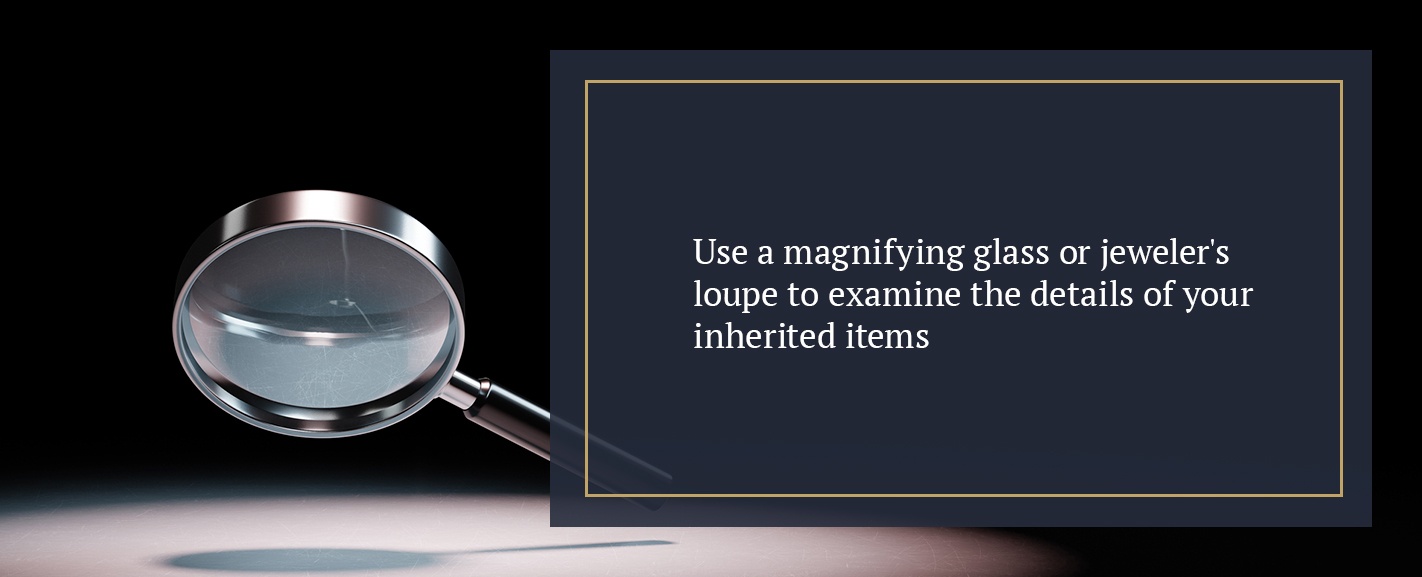
If you’re looking into finding the value of jewelry, you might have pieces with gemstones. With no documentation or knowledge of an item, you will not know what type of stone your piece has or its quality. These elegant accents can be a significant clue for the value of jewelry, so checking them is essential. Use a magnifying glass or jeweler’s loupe to examine the details of your inherited items, including these qualities:
- The size: A gemstone’s size isn’t always an indicator of fine or costume jewelry, but it can help you determine what you have. If your inherited jewelry has a large, clear stone, it could be cubic zirconia instead of a white diamond. You can commonly find large varieties of other gemstones, like amethyst, peridot and fire opal, so it depends on what stone you think your jewelry has.
- The setting: Costume jewelry typically has stones glued to the jewelry’s surface. Elaborate settings or thick prongs often indicate fine items. Look for details like a flush- or tension-set stone or a bezel setting, and you could have inherited a piece of fine jewelry.
- The cut: This quality refers to a gemstone’s shape and polish that transform an uncut stone into something brilliant. Most jewelry houses cut cubic zirconia in a round brilliant cut to mimic diamonds. If your gemstone has a unique shape and what looks like hand-faceted details, it’s often more likely to be a precious stone.
Without gemological experience, examining an item’s stones can be challenging. An expert can determine what type of stones your inherited jewelry has, along with details like the size, cut, clarity and additional essential features.
Sort Inherited Jewelry
If you’re acting as an executor involving jewelry, you will need to know how to handle a jewelry inheritance. Begin by sorting the inherited pieces, which will make it easier to take ones for appraisal. If you know which pieces are fine and which are costume, start by separating the two styles. You can then consider sorting the inherited jewelry in the following ways:
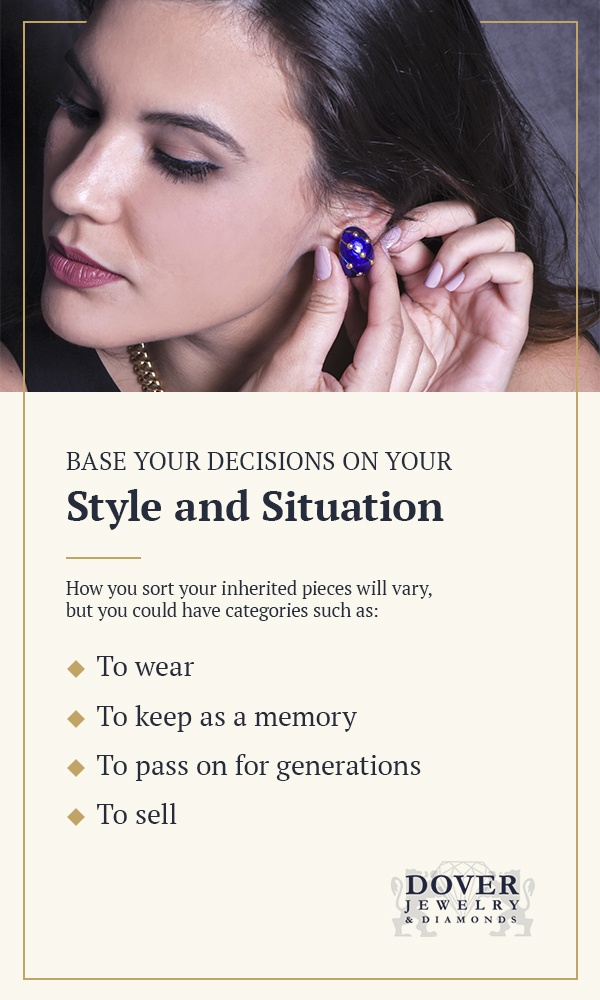
1. Base Your Decisions on Your Style and Situation
You could find that sorting through your inherited jewelry reveals different categories. Some of this jewelry you may wish to keep, and others you might consider selling. As you sort through the jewelry, base your decisions on your style and your situation. You might have your own heirs to consider, or you can decide based on whether an item fits your particular style. How you sort your inherited pieces will vary, but you could have categories such as:
- To wear: Some inherited jewelry is too beautiful to hide away. If you discover quality pieces in your inherited collection, you might consider adding them to the collection of items you wear for special occasions. Ensure you keep the items safe as you wear them, avoiding contact with perfumes, soaps and lotions, and store them appropriately when you are done wearing them.
- To keep as a memory: You might find pieces that are too delicate to wear but too special to sell. You might ultimately hold onto those pieces to preserve the memory of your loved one. Store these appropriately, depending on the metals and gemstones. Store diamonds with diamonds since the hard gemstones could scratch others, and put soft materials like pearl in silk or cotton bags away from different stones.
- To pass on for generations: Perhaps you’ve inherited a wedding or engagement ring or another sentimental item. You may not wish to wear this piece because it has too much sentimental value, but you might dream of passing it down to heirs of your own. Make arrangements to store the jewelry safely and have it legally pass down to your heirs through your will or trust.
- To sell: Not every item will have sentimental value, and that is perfectly acceptable. You might decide to have a professional appraise these items and sell them instead of holding onto them. Perhaps you do not have the space in your own collection, or you believe a collector will appreciate finding the fine item for their own use.
2. Determine What Needs Repairs or Refurbishing
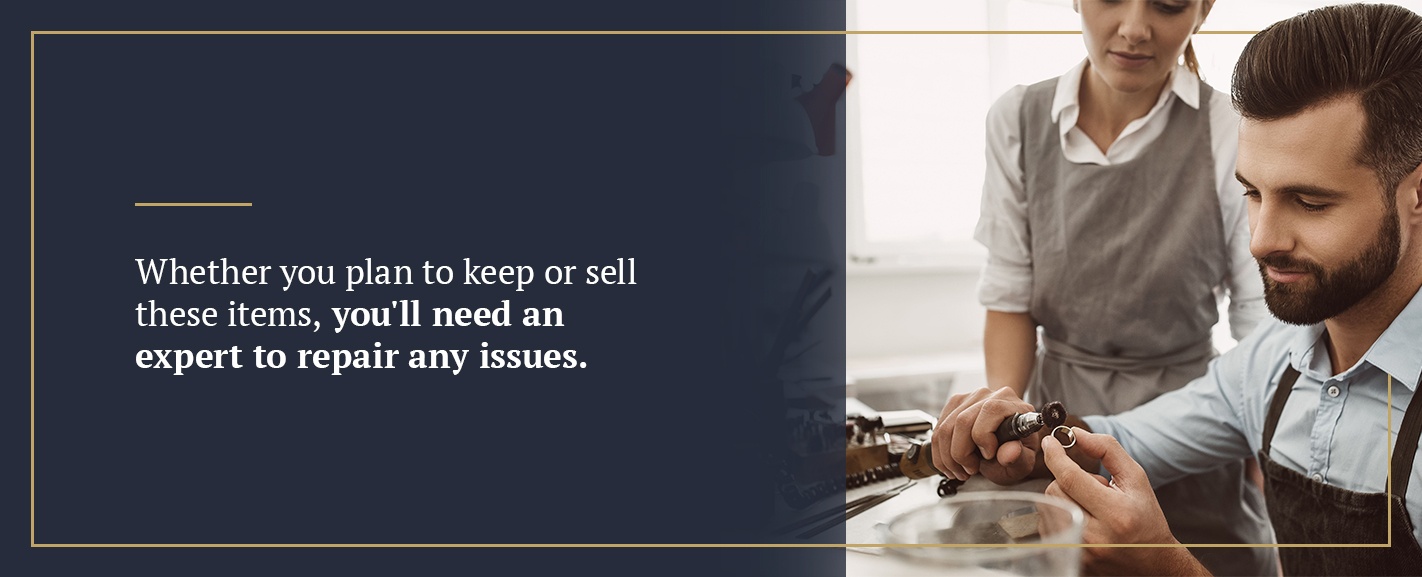
Vintage jewelry often needs repairs, polishing or refurbishing. Whether you plan to keep or sell these items, you’ll need an expert to repair any issues. That could increase or maintain the jewelry’s value, particularly if you plan to sell. Put pieces that require extra attention aside from ones that are in good condition. Possible signs of inherited jewelry damage and wear include:
- Bent or broken prongs
- Loose or missing stones
- Broken or missing links in chains
- Broken or missing clasps and closures
- Discolored or damaged metal
Consult with an expert to see how they recommend repairing those and additional concerns. Remember to consider a professional cleaning for your inherited pieces, as well. Trying to polish jewelry, especially older items, on your own could cause devastating damage. A professional will know the right cleaners, tools and methods to use to restore your vintage or antique jewelry to its full beauty.
3. Divide Everything for Multiple Heirs
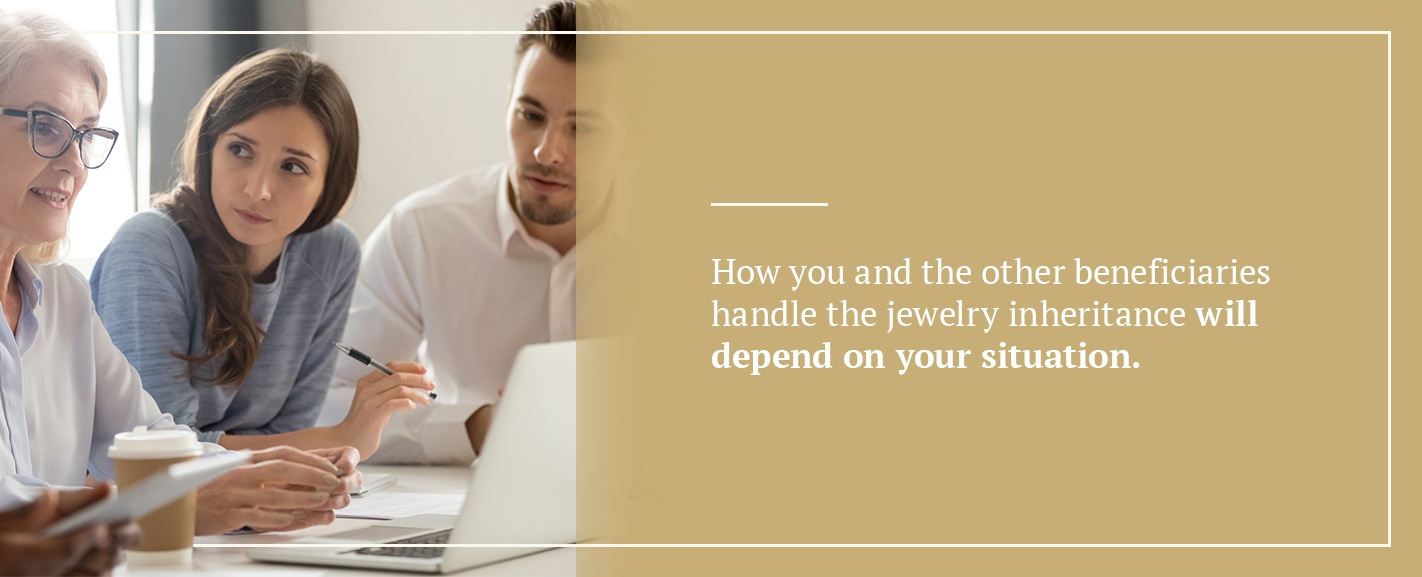
If you are not the only inheritor, you will need to understand how to execute a will with jewelry. You might have to collaborate with an estate attorney to understand the details of an inheritance. With legal matters aside, you may simply have to divide the jewelry for multiple heirs.
Dividing a jewelry collection among multiple heirs could be a challenge, depending on your situation. If your loved one has left specific terms in their will describing who should receive certain items, start there. If it is up to you and the other beneficiaries, you will need to divide everything evenly.
In this case, you’ll need a professional consultation. Take everything in the inherited collection for appraisal. You and your fellow heirs will then divide the pieces into equal worth. If anyone has favored pieces, they may buy them out or exchange for pieces currently set aside for them. How you and the other beneficiaries handle the jewelry inheritance will depend on your situation. If you and the heirs collectively decide to sell pieces, you will likely split the proceeds equally.
Consult a Jewelry Expert
An expert will offer the most assistance in how to know if your jewelry is worth something. As an executor, an appraisal will make your task easier. Keep in mind that because an appraisal is a legal document representing how much an expert believes a piece is worth, you should consult an experienced, trusted professional.
A professional appraiser can advise you on how to sell inherited jewelry and how to identify valuables in inherited jewelry. You might assume most individuals go to a professional wondering how they can sell their grandmother’s jewelry. But a professional offers much more than simply helping you sell your collection.
Why Seek an Estate Jewelry Appraisal?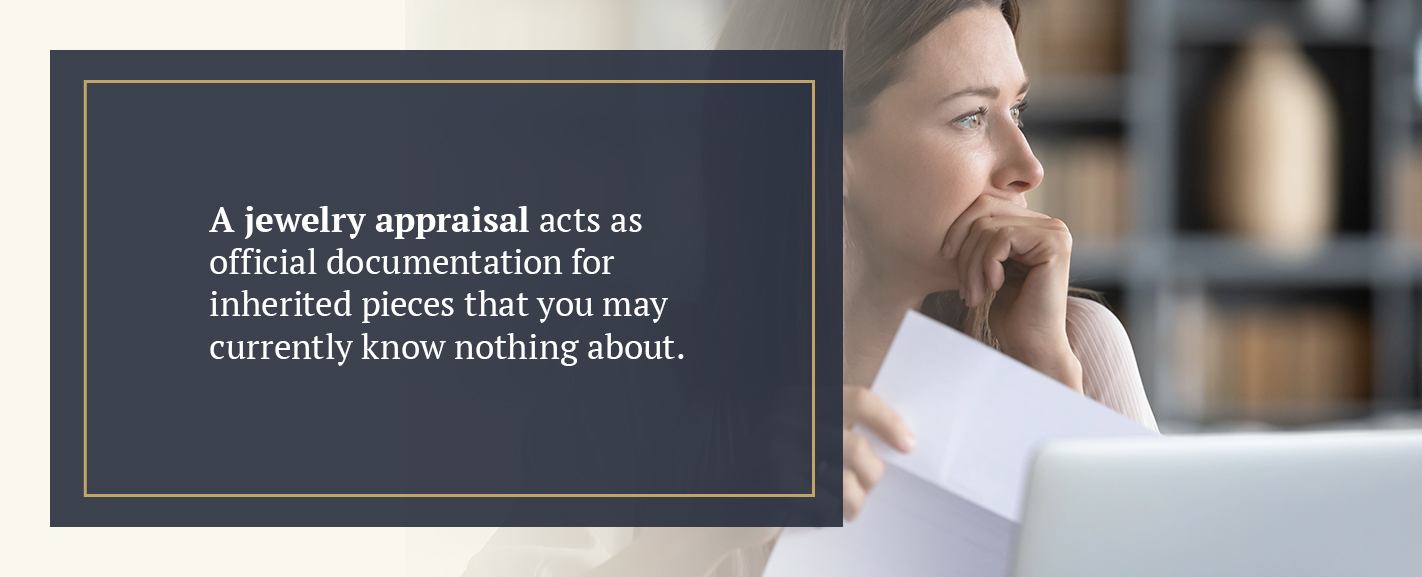
Estate jewelry may not always have documentation. That could make it a challenge to determine the value of jewelry or sell parts of the collection. A jewelry appraisal acts as official documentation for inherited pieces that you may currently know nothing about. You should seek a jewelry appraisal for your inherited pieces because it helps with:
- Discovering value: The primary reason to seek an estate jewelry appraisal is to understand the value of everything in the collection. You may discover rare or valuable pieces among everything. That could change how you sort through the collection. Note that an appraisal does not add value to your jewelry, and it serves primarily as an educated estimate.
- Insurance purposes: You might wish to purchase insurance to protect valuable pieces you plan to keep. Having an idea of what your jewelry is worth gives you a more accurate insurance quote, and most insurers require a jewelry appraisal before they agree to work with you. An insurance company may use the appraisal as proof of ownership if the items are lost or stolen. You may also use an appraisal to insure your jewelry if you must send it anywhere.
- Selling purposes: You and fellow heirs might not keep everything in the estate collection. In that instance, you could all decide to sell certain pieces. An appraisal is the first step of the fine jewelry selling process in many cases. Receiving an appraisal for everything in an estate can make selling pieces simpler later. While the value listed on an appraisal is an estimate and doesn’t always reflect the exact amount you would receive if you decide to sell, it does give you an idea of your jewelry’s worth.
- Dividing the inheritance: With additional beneficiaries to a will, you will need to divide a jewelry collection evenly. Unless your loved one has specified certain pieces for some individuals, you must know what the collection is worth to make it fair. Seek an appraisal that identifies the worth of individual pieces to assist you in dividing the inheritance. Explain to the appraiser that this is your purpose for getting an evaluation.
- Planning your own estate: Perhaps the process of being an executor involving jewelry has inspired you to plan for your own estate. An appraisal will make it easier to divide pieces among your heirs in your own will or trust.
What Is Included in an Appraisal?
This document primarily includes information about the jewelry item appraised. A professional will outline the item’s qualities, such as the jewelry’s weight and the diamond or gemstone’s weight. If your piece has a diamond, the appraisal will likely include an evaluation of its approximate color and clarity. An expert might also identify the type of metal the jewelry is made of.
In some instances, an expert will tailor a jewelry appraisal to your purpose. The appraisal certificate may include a statement of the appraisal purpose, but the essential part of an appraisal will be the definitive statement of value. That number will help you plan what to do with inherited jewelry, whether you decide to sell or keep it.
The specific details in your inherited jewelry appraisal vary based on whom you go to for appraisal services. At Dover Jewelry, our appraisal certificates include details such as:
- Age of the Piece
- Gemstone cut
- Insurance value
- Quality
- Type of metal
Where to Sell Inherited Jewelry
Perhaps you have items that don’t suit your style and don’t have as much sentimental value as others. You’ll need a trusted professional to sell your jewelry to. Many buyers and sellers also staff experts and offer appraisal services, making the selling process simple. At Dover Jewelry, we offer both appraisal and selling services for your convenience.
With a team of Certified GIA Gemologists, Master Jewelers and Customer Service Liaisons, the professionals at Dover Jewelry are dedicated to trust and transparency. Our cutting-edge technology and jewelry grading services allow us to provide appraisal reports for your unique needs.
We understand selling inherited jewelry can be a difficult process, whether as a result of emotional attachment or conflicting opinions from heirs. If you are a will’s executor, you have the right to decide if you’ll sell part or all of an inherited jewelry collection. We would be happy to assist you through the appraisal process, and if you decide to sell any of your pieces, we can assist you as well.
Contact the Experts at Dover Jewelry
With authentic antique or vintage jewelry in your estate collection or valuable modern-day pieces that you’d like to sell, seek an evaluation and selling opportunity with Dover Jewelry. For decades, Dover Jewelry has helped countless individuals discover the value of their inherited collections. Whether you will hold on to these pieces to pass down through generations or you’ve decided to sell, we will be here to guide you.
Seek our appraisal services to learn more about your inherited collection. For trustworthy service, you can sell your fine items to us. Contact our gem specialists today to learn more about our appraisal or selling processes.



